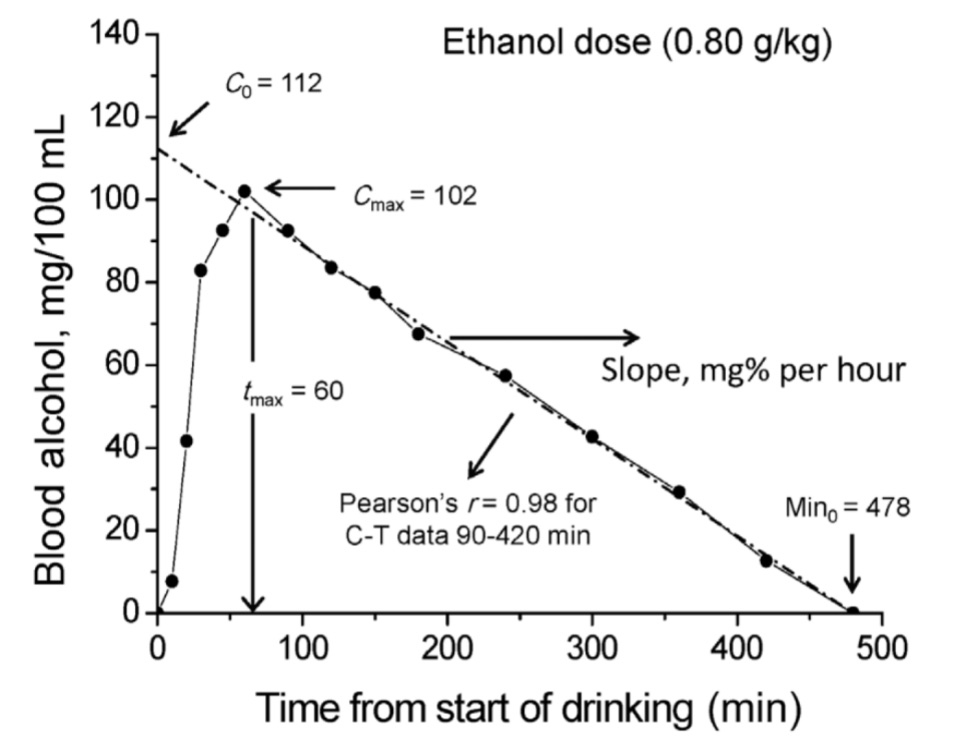CJC-F, CJC-F Announcements, CJC-F Forensic Toxicology
Legal limits of drink-driving
Many people are aware that there is a legal limit to how much alcohol we can have in our blood while driving – think roadblocks and breathalysers. But what exactly is the legal limit and why is it at this level?
There are broadly two ways of measuring alcohol content – by taking the amount per 100ml of breath or per 100ml of blood. The legal limit per 100ml of breath is 35 micrograms of alcohol, while the legal limit per 100ml of blood is 80 milligrams of alcohol. These limits, above which, typically correspond to some observable detrimental effects of alcohol on human cognitive function.
How is blood alcohol concentration (also known as BAC) calculated?
BAC is a measurement of the amount of alcohol in a person’s bloodstream. As alcohol is able to impair a person’s cognitive and psychomotor functions, knowing BAC can help infer the mental capacity of a person at a specific time of interest. There are several factors affecting BAC, including one’s body size, physical conditions (including liver impairment and genetic polymorphisms), gender, age, the food consumed that day, type of alcohol, and amount of alcohol consumed (based on the volume of drinks and the percentage alcohol). These affect alcohol absorption and distribution in the body. As BAC increases, the level of alcohol-related impairment that one would experience expectedly increases. While the legal limit is set at a BAC level of 0.08%, at lower values there would also be effects which can impair one’s judgement.
While there are legal limits to both blood alcohol concentration (BAC) and breath alcohol for drivers on the road ,breath alcohol has a higher tendency of being affected by external factors.
In some cases, BAC might not be taken immediately at the time the offence of drink driving was committed. Thankfully, the BAC at the time of the offence can be estimated via two ways: (1) by multiplying the rate of alcohol metabolism with the duration between the time of offence and the time which the BAC was measured, and then adding that to the BAC that was measured; or (2) by multiplying the rate of alcohol metabolism with the duration between the time the alcohol was drunk and the time the offence was committed, and then deducting that from the calculated amount of alcohol drunk (this second method is only useful if the type(s) and amount(s) of alcohol the person had consumed is known).
In general, the rate of alcohol metabolism is nearly consistent at around 0.016% per hour after the person stops drinking. While there may be factors affecting alcohol metabolism such as eating before drinking, the increase in alcohol metabolism is marginal. As such, the BAC level at that time of interest can be calculated from a known BAC level based on the time passed even if it was not taken immediately at the time of the offence. Note that alcohol metabolism and alcohol absorption are different concepts. The rate of alcohol absorption can also affect the BAC level.
Factor | How BAC is affected | Mechanism |
Age | Drinking the same amount of alcohol will result in a higher BAC level for an older person than a younger person. | Older age can decrease the percentage of water in the body.This can decrease the volume of distribution of alcohol since alcohol is hydrophilic (water-loving) which in turn increases BAC. |
Body size | Higher BAC level for people with low body weight. | People with low body weight will have less water in the body as well. This decreases volume of distribution of alcohol, increasing BAC |
Food | Higher BAC if one was drinking on an empty stomach. | Drinking on an empty stomach will result in rapid gastric emptying and results in a faster absorption of alcohol into the blood |
Type of alcohol | Higher BAC for drinks with higher ethanol content and for drinks with carbon dioxide content | Higher ethanol content and presence of carbon dioxide in drinks will increase absorption rate, leading to higher BAC levels |
Alcohol percentage in drinks (%) by alcohol by volume (ABV)
Vodka | 40-95 | Gin | 36-50 |
Rum | 36-50 | Whiskey | 36-50 |
Tequila | 50-51 | Fortified wine | 16-24 |
Beer | 4-8 | Unfortified wine | 14-16 |
BAC can be calculated using the Widmark equation:
BAC= [Alcohol consumed (g) x 100]/[body weight (g) x r]
The values of r are often taken to be 0.55 for females and 0.68 for males. This is due to the different percentages of water in males and females, with females having a lower percentage of water in their bodies. However, it is important to note that typical Widmark calculations may overestimate the BAC levels for heavy drinkers due to tolerance. and would be more reliable at lower alcohol consumption levels due to saturable metabolism kinetics.

This graph shows the BAC level of a male in a controlled drinking experiment (0.8g/kg ethanol on an empty stomach over 20-30 minutes).
In forensic science, the following equation is often relevant in calculating one’s BAC a certain number of hours after starting to drink, known as BACt. BACt=[ethanol consumed/(body weight x Vd)]-(βt), where β is the zero-order elimination rate from blood per hour for t hours since drinking started. Vd refers to the volume of distribution of alcohol in this equation, which is related to percentage of water in the body since ethanol is dissolved in water rather than other biological substances (e.g. fats). A higher Vd due to higher percentage of water in the body means that the BAC would be lower if the other factors are the same as someone with a lower Vd.
Why is there a legal limit for alcohol when driving?
The extent to which a person’s cognitive and psychomotor functions is impaired by alchol depends on the BAC level. At a BAC level of 0.02%, there would be a decline in a person’s ability to track moving objects and to multitask. At a BAC level of 0.05%, there would be additional reduced coordination and response time to emergencies and difficulty steering. At 0.08%, one would experience a decline in ability to process information, lack of speed control, reduced concentration, short-term memory loss and impaired perception. At higher levels, some effects include impaired vehicle control, dysphoria predominates and loss of consciousness.
Based on research, scientists determined that our coordination is noticeably impaired at a leve of 0.08%l. For instance, having a BAC over 0.08% impairs our ability to accurately retrieve signals from our brains – to either our hands on the steering wheel or our feet on the brake pedal.
In some cases, the defendant’s claims may be different from the evidence present. For example, a driver is stopped by the police after a social gathering and gives a positive breathalyser test. However, he claims that he did not consume alcohol and only consumed iced coffee. Eventually, it was found that the coffee was laced with Brandy. This is where a forensic toxicologist would come in. Forensic toxicologists can analyse biological specimens and determine alcohol and/or drug involvement in intoxication, suspected driving under the influence (DUI) and drug-facilitated crimes (e.g. rape, theft). They would be able to find and analyse the forensic evidence and come up with appropriate expert opinions on the case.
Legal Consequences
Under s 67 of the Road Traffic Act (RTA), a person is guilty of drink driving if he (1) is incapable of having proper control of the vehicle, or (2) has a blood alcohol level that exceeds the legal alcohol limit. This means that while BAC is relevant, even persons below the limit can be charged with drink driving if they are found to not have control over their vehicle.
Moreover, although an accused person’s alcohol content may be taken a substantial time after the offence, s 71 of the RTA states that the accused is presumed to have no less BAC than the specimen at the time of the offence. This presumption can be rebutted if the accused proves that he drank alcohol after driving without which he would have proper control of the vehicle or would not exceed the legal limit.
The RTA states that a fine between $2,000 – $10,000 (for first-time offenders) and/or an imprisonment term up to 2 years may be imposed for a drink-driving offence under s 67. There is also a mandatory disqualification period.
Given that higher BAC has more severe effects on the drinker and is therefore more dangerous, it is no wonder that the alcohol content level plays a part in sentencing considerations. Under the amended RTA, the High Court held that the indicative range of fines and disqualification period would be as follows:
Level of alcohol (μg per 100ml of breath) | Range of fines | Range of disqualification |
36–54 | $2000–$4000 | 24–30 months |
55–69 | $4000–$6000 | 30–36 months |
70–89 | $6000–$8000 | 36–48 months |
≥ 90 | $8000–$10000 | 48–60 months (or longer) |
As seen, the higher the BAC, the higher the level of culpability of an offender and therefore, the harsher the sentence.
Nonetheless, there are two important things about this framework. Firstly, this framework only applies to cases whereby no harm to person or property has eventuated. Secondly, the sentencing range provided in the framework are only neutral starting points. The court will also consider aggravating or mitigating circumstances relevant to the facts of each case, and a jail term could well be imposed if the former is present.
Long story short, avoid drinking and driving! If you’re going out to drink, take a taxi or have a designated driver in place. No one’s life is worth the risk, and fines, disqualification and possibly imprisonment certainly aren’t worth it either.
*The views and opinions expressed in this article do not constitute legal advice and solely belong to the author and do not reflect the opinions and beliefs of the NUS Criminal Justice Club or its affiliates.
References
- IRB Law LLP. (2021, May 31). Drink Driving Penalties and Alcohol Limits in Singapore – IRB Law LLP. IRB Law. Retrieved January 14, 2022, from https://irblaw.com.sg/learning-centre/drink-driving-in-singapore/
- B.T. (2020, March 12). Blood Alcohol Content and the Legal Drinking Limit. Verywell Mind. Retrieved January 14, 2022, from https://www.verywellmind.com/blood-alcohol-content-62695
- Low, S. (2017, November 23). Festive Drinking: How Much Alcohol Can I Have Before Driving? Mount Elizabeth Hospital. Retrieved January 14, 2022, from https://www.mountelizabeth.com.sg/healthplus/article/festive-drinking-driving
- Why and How Did .08 Become the Legal BAC Limit? (2019, December 11). Kanner & Pintaluga. Retrieved January 14, 2022, from https://kpattorney.com/why-how-08-become-legal-bac-limit/
- American Addiction Centers Editorial Staff (2022, January 5). .08: Why is this the “Magic” number? DrugAbuse.com. Retrieved January 14, 2022, from https://drugabuse.com/blog/08-why-is-this-the-magic-number/
- Forensic toxicology: Forensic service providers: Forensic equity. (n.d.). Retrieved January 14, 2022, from https://www.forensicequity.com/forensic-toxicology
- DUI: Here are the penalties for drink-driving in Singapore. (2021, May 07). Retrieved January 14, 2022, from https://singaporelegaladvice.com/law-articles/dui-penalties-drink-driving-singapore/
- DrinkFox. (n.d.). How long does alcohol stay in your system? DrinkFox. Retrieved February 24, 2022, from https://www.drinkfox.com/information/alcohol-metabolism
- Alcohol percentage contents of various beverages. Sunrise House. (2021, July 12). Retrieved February 24, 2022, from https://sunrisehouse.com/stop-drinking-alcohol/percentage-contents/
- Jones AW. Alcohol, its absorption, distribution, metabolism, and excretion in the body and pharmacokinetic calculations. WIREs Forensic Sci. 2019;1:e1340. https://doi.org/10.1002/wfs2.1340
- Rafael Voltaire Alzate v Public Prosecutor [2021] SGHC 224 at [31]-[33]
- Shouse California Law Group. Breathalyzer Accuracy vs Blood Test – Which is Better? Last retrieved 2 March 2022 from: https://www.shouselaw.com/ca/blog/breathalyzer-accuracy-vs-blood-test/
Author’s Biography
 Nicole Teo is currently pursuing a degree in Law and in the middle of her second year of the programme. She is aspiring to be a prosecutor one day, which sparked her interest in all things related to criminal law, including forensic science.
Nicole Teo is currently pursuing a degree in Law and in the middle of her second year of the programme. She is aspiring to be a prosecutor one day, which sparked her interest in all things related to criminal law, including forensic science.

Ellione is a Year 2 Chemical Engineering student pursuing a minor in Forensic Science. She has a great interest in toxicology and hence joined the Forensic Toxicology project to learn and understand more about how toxicology can be used in the law. As a project manager for Forensic Pathology as well, she works with her team to increase awareness and interest in this aspect.
Edited by: Celine Cheow and Cherylynn Tan

